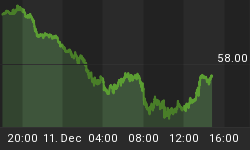Now that yields on ten-year Treasuries have cracked through 5%, on their way to infinity and beyond, many on Wall Street are wondering how high rates must go before bonds begin to draw investors away from stocks.
Most equity analysts are sounding the all-clear by proclaiming that 5.25% - 5.5% ten-year yields do not offer a significant threat to stocks. Although I agree that this is true, I don't share their confidence that 5.5% represents any kind of a ceiling for rates. The important issue is not the point at which bonds become attractive relative to stocks. Rather it is the point at which they regain their attraction to foreign central banks, whose massive purchases of Treasuries have lost steam amidst rising global rates and lost confidence in the U.S. Dollar, and to private foreign savers, who have already abandoned treasuries for better performing assets.
The truth is that the fundamental lack of appeal of Treasuries on the global market means that rates will rise considerably from here, which is very bearish for stocks indeed. Given the real rate of inflation (not the phony rate implied by the CPI) and the potential for a protracted decline in the value of the dollar, rates must rise significantly in order to convince overseas buyers to stay in the game.
However, a significant move up in interest rates will depress corporate earnings considerably. Not only do corporations themselves have debt to service, but so do their customers, particularly those with adjustable rate mortgages. If higher mortgage payments consume a greater share of discretionary income, then consumers will have less money to spend on other goods or services. Compounding the problem for stocks is the fact that while higher interest rates depress earnings, those diminished earnings themselves will need to be discounted by a higher factor: a double whammy for stock prices!
A falling stock market however would be just a minor casualty resulting from significantly higher rates. A bigger concern is the health of the over-leveraged U.S. economy itself. Interest rates high enough to offer an attractive yield to foreigners would be a disaster for U.S. consumers awash in credit card and adjustable rate mortgage debt, corporations issuing record amounts of low-rated bonds, and the Federal government itself, which continues to issue record amounts of Treasury bonds. To bail out the strapped debtors, prop up falling asset prices and limit loan defaults, the Fed will need to pursue a more inflationary monetary policy. The resulting surge in inflation would render unattractive any bond yield previously thought to be attractive. What would be gained nominally would be lost in real terms.
In fact, our nation has spent so much money that we did not have to buy foreign products we could not afford, and amassed such staggering amounts of debt collateralized by inflated assets, that it is now virtually impossible for bonds to ever offer competitive real yields. The only way that could happen would be for the Fed to stand idly by and allow our economic house of cards to collapse and tighten monetary policy while it happened. Even then, bond prices would collapses, but under that scenario at least they would bottom out. If the Fed tries to "rescue" the economy, it's a bottomless pit!
It is amazing that citizens of a savings-short nation so completely dependent on foreigners to finance its borrowing can remain oblivious to the threat of higher interests rates should foreigners lend elsewhere. Recent action in the bond market suggests that this arrogant false-confidence is about to be shattered.
For a more in depth analysis of the tenuous position of the Americana economy and U.S. dollar denominated investments, read my new book "Crash Proof: How to Profit from the Coming Economic Collapse." Click here to order a copy today.
More importantly make sure to protect your wealth and preserve your purchasing power before it's too late. Discover the best way to buy gold at www.goldyoucanfold.com, download my free research report on the powerful case for investing in foreign equities available at www.researchreportone.com, and subscribe to my free, on-line investment newsletter at http://www.europac.net/newsletter/newsletter.asp.
















